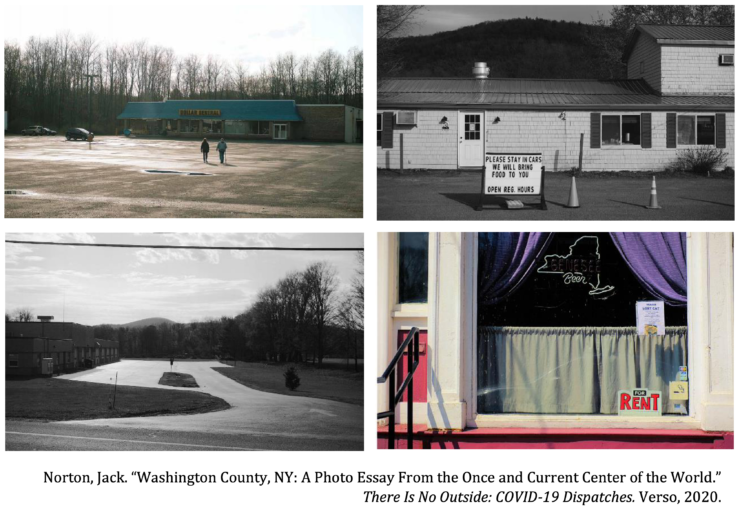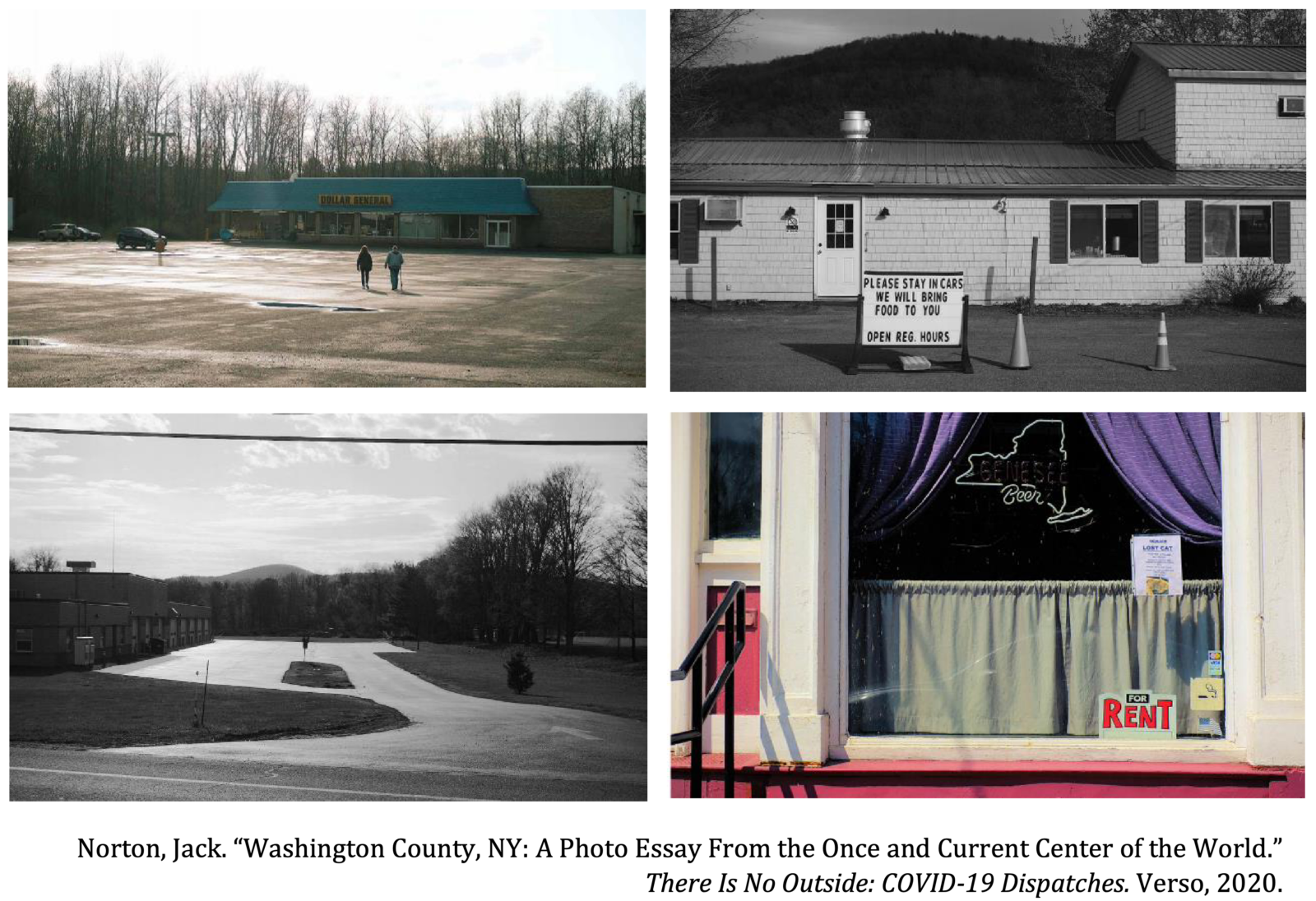[urban interfaces] Blogs
guest blogpost: Kim Sommer – Photography, Spectrality and Urban Space
For our [urban interfaces] seminar series on the theme The Magic City (2021-2022), we invited participants to write blogposts. The best and most interesting ones we publish on our website.
Below is the blogpost for session #1, written by Kim Sommer.
Kim Sommer is a student of the Media, Art and Performance program at Utrecht University. Although her background is in Film and Literary Studies, her present interests lie primarily with affect, (post)phenomenology and new materialism as conceptual lenses to explore and probe the boundaries of expanded cinema. She is currently the manager of the Netherlands Institute for Cultural Analysis, and works as a teaching/student assistant at Leiden University and the University of Amsterdam.
Photography, Spectrality and Urban Space
by Kim Sommer

A desolate restaurant with a sign saying you should remain seated in your car; an empty parking lot in front of a supermarket; an abandoned window stall with its usually inviting neon-lights died out. Jack Norton’s photo series ‘A Photo Essay From the Once and Current Center of the World’ consists of multiple photographs of Northern New York in times of COVID-19. The scenes display a COVID-19-induced urban void that is more commonly filled with noise and livelihood. The photos rob the depicted urban spaces of their usual affordances and significations, instead thrusting them in a condition of defamiliarization. We cannot quite grasp the scenarios through looking at the photos as their animating core remains elusive. When seeing the project, an adjective coming to mind is ‘ghostly’ or ‘spectral’ as all photos possess an eerily liminal quality.
This blog will be dedicated to exploring how the spectral – alongside related concepts such as the ghostly or Magic – helps us to understand and re/conceptualize the challenges and (technological) transformations of urban spaces. More specifically, I will look at the technologically mediated ‘urban spectres’ of Norton’s photo-series as I conceive of both space and technology as always already being imbued with spectral qualities in their layering of lived/living experiences (or the lack thereof). Although the spectral by nature refuses fully being grasped experientially or discursively, these elusive spectres nonetheless form the foundation for the spatiotemporal and affective fabric of urban realities that bodies both co-constitute and are situated in. Using Norton’s photographic project and Federico Campagna’s writing on the cosmogonies of Magic and Technic, I will explore here the magic and spectral qualities of (urban) space and photography.
Technic and Magic’s cosmogonies
The Derridean spectre – as a specific kind of liminal ‘presence-absence’ – can be considered something ungraspable, yet as Campagna would contend, also the very thing that animates our everyday life. ‘Spectrality’ or ‘Magic’ are not to be understood as standing beside reality, but rather as alternative onto- epistemologies that are diffractively entangled with the hegemonic conception of ‘Reality’. Campagna’s concept of ‘Technic’s cosmogony’ asserts that the principles of absolute language and our faith in cognition are the dominant ‘reality-settings’, which numb our capacities for thinking/imagining beyond installed frameworks. Conversely, ‘Magic’s cosmogony’ is conceptualized as an alternative ‘reality-setting’ wherein the ‘Ineffable’ (or spectral) is at the core of existence as a capacious force that infinitely remains out of grasp. Harnessing this ineffable source of life through discursive, linguistic or cognitive frameworks would mean immobilizing it and thereby nullifying its affective thrust. Magic’s cosmogony then places a liminal, inaccessible ‘spectre’ at the core of existence as something of which its essence is endlessly deferred, whilst it is simultaneously responsible for infusing the essence of all life with the ‘Ineffable’ of existence. Having outlined Campagna’s cosmogonies of Magic and Technic, I will now position Norton’s photo series in this theoretical framework as I believe the project testifies to the way in which space and technology emerge in relational encounters that cannot be fully pinned down, and can therefore be conceptualized as ‘spectral’ or ‘Ineffable’.
Space: The agency of place
With regard to urban space, Michael Mayerfeld Bell has proposed that places make us believe that they are haunted by ghosts. His definition of ghosts is not grounded in discourses surrounding spirituality or Magic, but it does point to the way in which a place can induce feelings or bodily sensations, and therefore possesses (spectral) agency. This conception of places emphasizes how agency is not an attribute merely confined to the realm of humans, but is also imbued in material non-human bodies. Agency can be considered a distributed process, or ‘a relational effect generated in networks by humans and non-humans alike’ (Shobeiri 118), meaning that the materiality of place can interact with people and vice versa. Norton’s project treats the urban landscape accordingly: the photos attest to a mode of ascribing agency to the materiality of urban space. In doing so, the photos draw on a ‘spectral’ latent reality of lived/living urban experiences of non/human bodies (perhaps even another reality-system in the form of Magic’s Cosmogony). The ghostly ‘presence’ that the photos both incite and encompass point to alternative ways of thinking- and being-in-the-world. It does not serve as a totalizing representation of ‘the urban spectres’ of the area, but it instead serves to communicate a ghostly presence via the photos in order to destabilise the dominant understanding of a specific space and its urban configurations. In allocating different meanings and ways- of-being in space, these ghostly stories do not transmit ‘the spectral’ as such (which cannot exist as an undifferentiated whole) but they can point to other ways of thinking or being in (urban) space. By approximating one alternative relational onto-epistemological worldview, the multiplicity of onto- epistemologies in urban spaces is implied.
Time: Photography’s irreconcilable temporalities
Specific to Norton’s project is moreover not merely the urban scenarios that it depicts (space), but also its photographically mediated nature and the particular associated mode of temporality (time), which I contend is a process embedding yet another layer of spectrality. Ali Shobeiri, drawing on Derrida and Stiegler, states that the photographic event is spectral by nature, due to the temporal incongruence that the medium posits. Photography possesses and creates a ‘ghostly existence’ that remains out of reach as it belongs to another temporal order: that of the past. The depicted scenario of any photo refers to ‘the temporal irreversibility caused by the pastness of photography, which constitutes a non-reciprocal gaze to which we cannot respond but nonetheless feel necessitated to do so’ (Shobeiri 127). In other words, photography takes a slice of life in the past to subsequently transfer it to the present of the viewer. Through this temporal juxtaposition, a liminal and incongruous spectral presence emerges: one that cannot be conceptualized or grasped, but demands a response nonetheless. The ghostly effect of photography’s irreconcilable temporalities is emphasized in Norton’s photographic project since its bare and minimal compositions do not foster any (expected) action or narrative development. It is not a slice taken from an active scenario wherein bodies intentionally move and make use of the urban affordances of a given space. The photos rather present the absence of action without pretence of action-to-come. As such, the explicit temporal ‘pastness’ in Norton’s project allows for the (always already present) spectral qualities of the medium of photography to be foregrounded.
–
Summarizing, Norton’s bare photographic compositions ascribe agency to the materiality of space. They foreground the spectral agency imbued in (urban) space, acknowledging its status as a relational assemblage that comprises of both human and nonhuman bodies. In photographically mediating these relational, spectrally imbued urban spaces, another layer of temporal spectrality is embedded. The medium of photography is considered to be inherently spectral, because of its irreconcilable difference between pastness and presentness, resulting in an impasse wherein an ungraspable ghostly (temporal) presence- absence emerges. This traumatic temporal irreversibility is foregrounded in Norton’s photos as they emphasize their emptiness without fostering any overt expectation for action. As such, Norton’s project decontextualizes urban spectres from Technic’s cosmogony to instead reterritorialize them in service of the alternative onto-epistemology of Magic’s cosmogony.
Cited works
Bell, Michael Mayerfeld. ‘The Ghosts of Place.’ Theory and Society, vol. 26, no. 6, 1997. pp. 813-836.
Campagna, Federico. Technic and Magic: The Reconstruction of Reality. Bloomsburt, 2018.
Norton, Jack. “Washington County, NY: A Photo Essay From the Once and Current Center of the World.” There Is No Outside: COVID-19 Dispatches. Verso, 2020.
Shobeiri, Ali. Place: Towards a Geophilosophy of Photography. Leiden University Press, 2021.

